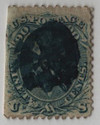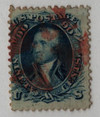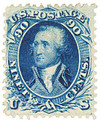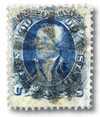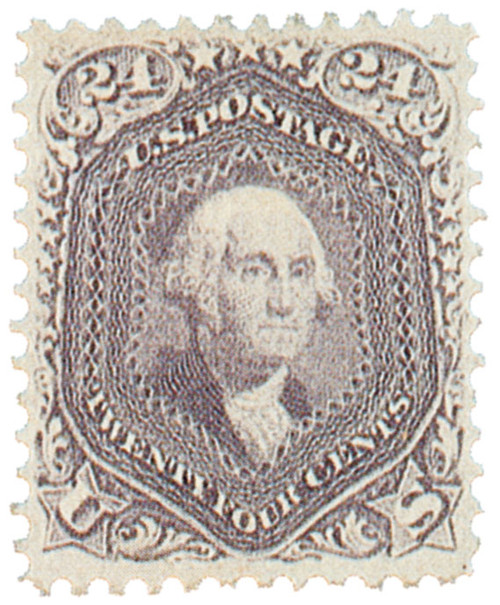
# 72 - 1861-62 90c Washington, blue
U.S. #72
1861 Washington
- Replaced previous 90c stamp after it was demonetized
- Paid postage on mail to India, China, Australia, foreign countries
- Quite a few covers to China franked with 90c value survive
Stamp Category: Definitive
Series: 1861-62 Issue
Value: 90c
Earliest Documented Use: November 27, 1861
Printed by: National Bank Note Co.
Quantity printed: 38,700 (estimate)
Format: Printed in sheets of 200 stamps, divided into vertical panes of 100 each
Printing Method: Engraving
Perforations: 12
Color: Blue
Why the stamp was issued: Though there was no specific 90c postal rate at the time, the denomination was used to pay the double rate postage to India, Australia, and other foreign countries. It could also be combined with stamps of different denominations for postage to other foreign destinations and heavier weight packages.
Demand for the high-value stamp was expected to be low and relatively few were produced. The high cost (well over $140 today) was too much for many collectors who weren’t able to afford it.
About the printing: The design was engraved on a die – a small, flat piece of steel. The design was copied to a transfer roll – a blank roll of steel. Several impressions or “reliefs” were made on the roll. The reliefs were transferred to the plate – a large, flat piece of steel from which the stamps were printed.
About the design: The image of George Washington in his dress uniform is based on a painting by George Trumbull, a well-known artist of the time. Trumbull created 16 paintings of Washington before he became president.
About the 1861-62 Series: The series consists of US #63-72. The same face values and subjects found in the 1857-61 series were used in the new one. The colors are generally similar as well. The frame designs vary greatly from the preceding series. While the denominations on the 1857-61 issues were written out, the denominations on the new series were now also shown in numerals displayed in the upper corners of the stamps. This helped distinguish them from the previous series, which could no longer be used.
History the stamp represents: Due to the outbreak of the Civil War, all US stamps were demonetized and declared invalid for postage. This prevented the Confederate States of America (CSA) from selling them and using the money to support the Southern war effort.
The new 1861 stamps were sent to post offices along with a notice that required an exchange period of six days be announced in local newspapers. During the exchange period, old stamps could be exchanged for new ones. After the six-day exchange period, the old stamps were no longer accepted as postage.
U.S. #72
1861 Washington
- Replaced previous 90c stamp after it was demonetized
- Paid postage on mail to India, China, Australia, foreign countries
- Quite a few covers to China franked with 90c value survive
Stamp Category: Definitive
Series: 1861-62 Issue
Value: 90c
Earliest Documented Use: November 27, 1861
Printed by: National Bank Note Co.
Quantity printed: 38,700 (estimate)
Format: Printed in sheets of 200 stamps, divided into vertical panes of 100 each
Printing Method: Engraving
Perforations: 12
Color: Blue
Why the stamp was issued: Though there was no specific 90c postal rate at the time, the denomination was used to pay the double rate postage to India, Australia, and other foreign countries. It could also be combined with stamps of different denominations for postage to other foreign destinations and heavier weight packages.
Demand for the high-value stamp was expected to be low and relatively few were produced. The high cost (well over $140 today) was too much for many collectors who weren’t able to afford it.
About the printing: The design was engraved on a die – a small, flat piece of steel. The design was copied to a transfer roll – a blank roll of steel. Several impressions or “reliefs” were made on the roll. The reliefs were transferred to the plate – a large, flat piece of steel from which the stamps were printed.
About the design: The image of George Washington in his dress uniform is based on a painting by George Trumbull, a well-known artist of the time. Trumbull created 16 paintings of Washington before he became president.
About the 1861-62 Series: The series consists of US #63-72. The same face values and subjects found in the 1857-61 series were used in the new one. The colors are generally similar as well. The frame designs vary greatly from the preceding series. While the denominations on the 1857-61 issues were written out, the denominations on the new series were now also shown in numerals displayed in the upper corners of the stamps. This helped distinguish them from the previous series, which could no longer be used.
History the stamp represents: Due to the outbreak of the Civil War, all US stamps were demonetized and declared invalid for postage. This prevented the Confederate States of America (CSA) from selling them and using the money to support the Southern war effort.
The new 1861 stamps were sent to post offices along with a notice that required an exchange period of six days be announced in local newspapers. During the exchange period, old stamps could be exchanged for new ones. After the six-day exchange period, the old stamps were no longer accepted as postage.



